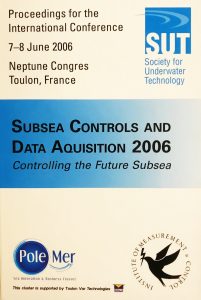Subsea Controls and Data Acquisition 2006
 Controlling the Future Subsea
Controlling the Future Subsea
Proceedings of the international conference, held June 2006
ISBN 0 906940 45 1, Hardbound, 2006
174 pp, 134 figures and tables, Colour
Subsea Controls and Data Acquisition (SCADA) is a unique, long established international conference which represents the oil industry control systems groups and deals with control, communication, remote data acquisition and the enabling technologies associated with hydrocarbon exploitation from the subsea environment. This conference is aimed at professionals working in the field of subsea engineering. The emphasis is placed on future technology requirements, availability and obsolescence. Equally, importance has been placed on global issues such as environment, decommissioning, deepwater problems and long–distance offsets.
Topics include: all–electric systems, seabed processing, fibre optic transmission and distributed systems. Reliability of systems continues to play a dominant role, coupled with contributions from professionals giving experience gained and new challenges to overcome. Subsea Controls and Data Acquisition 2006, therefore, is of interest to all in subsea engineering. Includes 134 figures and tables in colour and 14 chapters.
Contents
- The Need to Adopt a Proactive Approach to Obsolescence Management in Subsea Controls –
D Saul, BP Exploration Operating Co Ltd, UK - Application of Virtual Flow Metering as a Backup or Alternative to Multiphase Flow Measuring Devices –
B Bringedal, ABB AS Corporate Research, Norway; and A Phillips, Vecto Gray Ltd, UK - Opto–Electrical Solutions for Offshore Fields – M Fullenbaum, Alcatel Submarine Networks, France
- Composite Materials for Subsea Oil Separation –
D Micheaux et al, IFREMER; Bureau Veritas; CNIM; IFP; PROSERNAT; and TotalFinaElf, France - Using Platelet Technology™ to Locate and Seal Leaks in Long Subsea Umbilical Lines –
N Ryan et al, Brinker Technology Ltd, UK; BP E&P Technology, USA; Shell UK Ltd; and Shell, Ireland - Enabling Subsea Survillance – G Deans and R MacKenzie, Schlumberger, UK and USA
- Ultra–Long Offset ‘Subsea to Beach’ Controls Technology – Case Study, Statoil Snøhvit –
W Acworth, Vecto Gray Controls Ltd, UK - Development and Approval of HIPPS for Application in the Gulf of Mexico – CJ Lindsey–Curran, BP E&P Technology, USA
- Multi–Axis Finite Element Analysis of Helical Umbilical Structures in Bending, Tension and Crushing – A Dobson et al; Duco Ltd, UK; and Institut Français Du Pétrole, France
- Long Offset Control System Using All–Electric CameronDC System – W Menz, Cameron subsea Systems, Germany
- Subsea Architectures to Facilitate Increased Recovery from Reservoirs – R Neri and K Falk, Aker Kvaerner, Norway
- Tordis Subsea Separation Boosting and Injection (SSBI) Project – JH Neuenkirchen, Statoil, Norway
- Subsea Data Mapping – D Saul, BP Exploration Operating Co Ltd, UK
- Feasibility Study: SWIMMER, a Hybrid AUV/ROV for Intervention on Subsea Production Systems –
G Grenon et al, Cybernetix, and Total, France